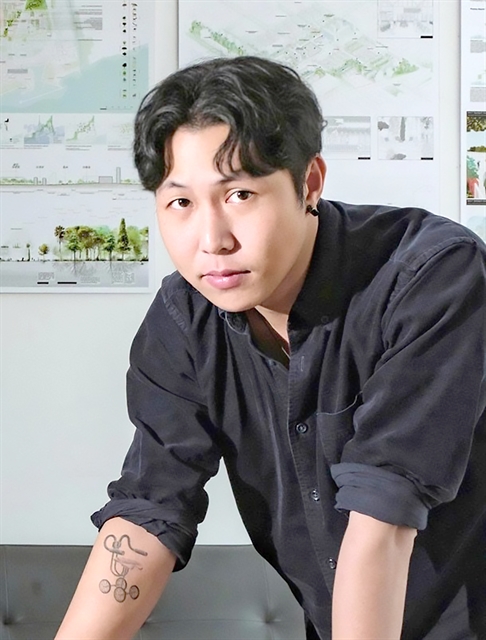Two architectural works, The Grid and House of Forest by Mai Hưng Trung, are on display at the 19th International Architecture Exhibition in Venice, Italy.
Trung spoke to Việt Nam News about his work and career.

Architect Mai Hưng Trung. Photo thethaovanhoa.vn
Two architectural works, The Grid and House of Forest by Mai Hưng Trung, are on display at the 19th International Architecture Exhibition in Venice, Italy.
Trung has won the European Prize, an architectural competition for people under 40 years of age, three times. Last year, he was honoured with the Seed 2024 Award from the Prince Claus Fund. He is currently a lecturer at the National School of Architecture of Versailles in France.
Trung spoke to Việt Nam News about his work and career.
Could you tell us why Hà Nội is always centred in your creativity, including the two works on display in Venice?
I have spent time studying in Europe, which gives me a broader view of architectural and cultural knowledge. Understanding more about how western society operates means understanding more about the east, too, including Việt Nam. I think a lot about how this can be integrated into general knowledge.
I understand and recognise that there is no single architectural or urban model that is standard. Applying stereotypes to an architectural model, or comparing apples to oranges, this society and other one, is considered a mistake.
Even in the 19th century, when the French wanted to turn Hà Nội into a version of Paris, they had to find a way to adapt their architectural or planning models to Việt Nam's tropical climate.
Adaptability depends on understanding the context. To do that, I still think that every architect has his own city. I'm not necessarily the person who loves or understands Hà Nội the most, but I think I'm quite attached to the city and know what I can bring to it or what it can bring to me.
Although I have worked in Hà Nội, I also face opposing opinions, sometimes criticism, misunderstanding and even being incriminated. Many times, I wanted to go to the south, but I thought that Hà Nội had not given up on me. In Hà Nội, wherever I go, it inspires me. It's delightfully messy and adaptively haphazard. It may seem like a problem to someone, but to me it's a solution.
After several years, even if a building's function changes, how can it remain in people's minds as urban memories or a living part of a place?
The ability to adapt to climatic, cultural and geopolitical environments is a prerequisite for contemporary architecture in the context of a world that is running out of resources. And we cannot build indefinitely.
Every architectural work now does not necessarily have to be limited to a certain function, but can have more than one. I often think about other life cycles of buildings, spatial structures that can change functions over time.
A house can become a public space or vice versa. A museum could one day transform into a multi-purpose community space. A school can be a disaster shelter. An abandoned office building can become a nursing home or children's daycare centre.
In order to preserve an architectural work, the most important thing is that right from the first strokes, the architect must take into account the future possibilities that the work will change.
Of course I don't mean that the architect has to be a prophet, but he can foresee the changing context and prepare for those possibilities based on observing what is available.
You often reuse old materials, sometimes even structures from existing buildings. Why?
Surely not only me, but probably more than 90 per cent of people who actually do architecture in the 21st century agree that reuse is really necessary. It's quite obvious in a built environment with so much nonsense going on every day due to being dominated by capitalist corporations.
This doesn't mean that I believe in the past more than the future, but I think that in any situation, we can find a way to hold a dialogue or deal with what is available, instead of imposing it arbitrarily.
Could you talk more about your works, The Grid and House of Forest?
I not only focus on human freedom, but also nature and wildlife. In the project House of Forest, I want to aim for architecture with minimal human intervention. More precisely, I want to bring about architecture that can wither or disappear into nature. It can blend into the landscape after a storm, it can become a habitat for migratory birds or it is a place where people come to take refuge, shelter or simply destroy it for fun.
The work is a structure that can change both its form and function. Architecture can adapt like a living organism depending on the place, climate or local culture.
If one day your works disappear, what do you want people to remember?
It's probably similar to what would remain if we disappear one day. I often think of this as a reaction of curiosity, but with absolutely no expectations.
One day when all the buildings are gone, I think maybe they will have completed their mission. Each person will have a different way of remembering them, loving or hating them.
The work may have been right in the past but wrong in the future, or it was wrong in the past but can be right in the present. What is wrong in the present can be right in the future.
As long as people talk about the work, it's alive. If architecture is not mentioned in poetry, cinema or religion, nostalgia would probably only last for one or two generations at most.
So sometimes, disappearance or destruction is the last and only permanent part of architecture. VNS